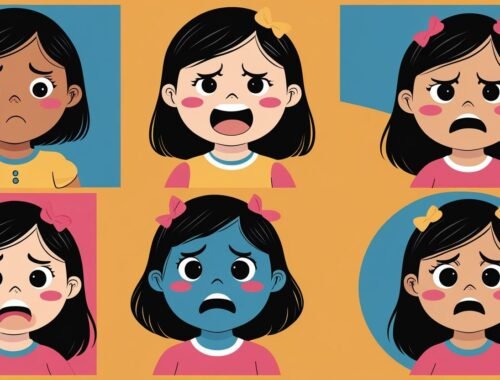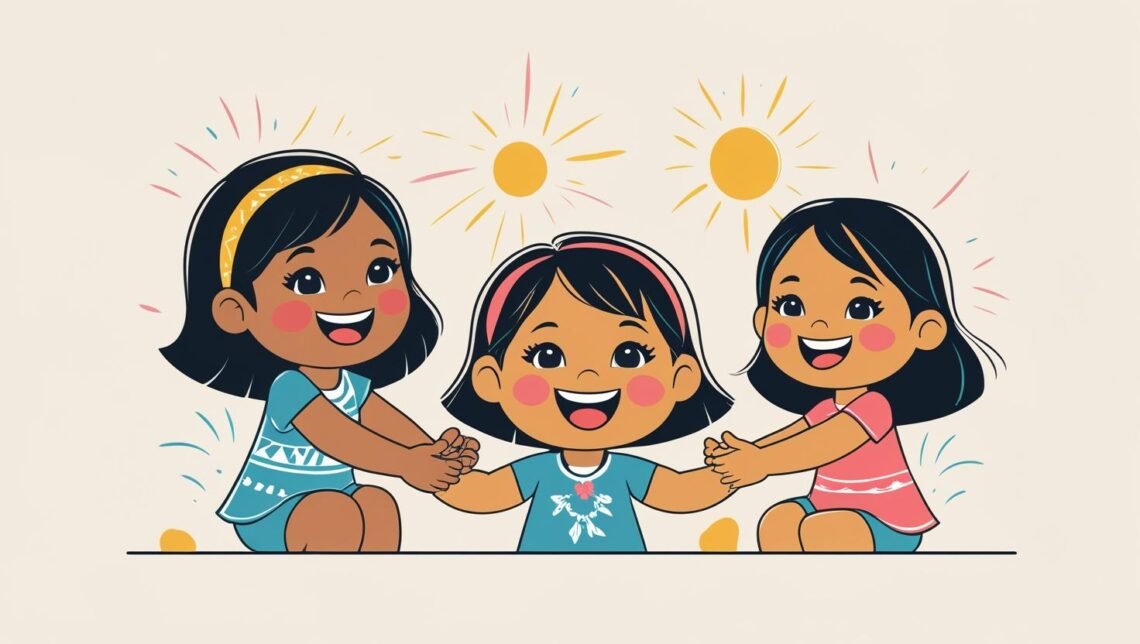
Emotional Intelligence: Teaching children about Motivation
In my last post, I explored self-regulation and the important role it plays in the development of children’s emotional intelligence. This time, we’re diving into another key piece of the puzzle: motivation.
In early childhood, motivation isn’t just about stickers or praise—it’s about helping children develop an internal drive, a sense of purpose, and the confidence to take on challenges because they want to, not just because someone told them to. Let’s take a closer look at how we can nurture this spark in our little learners and why it matters more than we might think

Motivation, as a key component of emotional intelligence, plays a vital role in a preschooler’s growth and development. At this stage, it’s not about gold stars or reward charts (well, not entirely)—it’s about helping children discover the joy of learning, the satisfaction of sticking with something challenging, and the pride that comes from reaching a goal. Motivation in early childhood is deeply connected to a child’s ability to manage their emotions and stay engaged. When children feel emotionally supported and learn to handle frustration or disappointment, they’re more likely to approach tasks with curiosity, enthusiasm, and persistence. As educators and caregivers, when we model emotional regulation and celebrate effort over outcomes, we help children build inner drive and resilience. By nurturing both emotional intelligence and motivation, we lay the groundwork for future academic success and meaningful social connections (Denham et al., 2012).
In this post, I’ll be unpacking a few key categories of motivation—intrinsic motivation, achievement motivation, and social motivation—as well as a look at self-determination theory (SDT) and goal orientation. Each section includes practical, classroom-tested ideas to help foster motivation in our little learners.
Intrinsic Motivation
Intrinsic motivation is that wonderful internal spark that drives children to engage in activities simply because they enjoy them—not because there’s a sticker or a snack waiting at the end. It’s the joy of building a block tower just to see how tall it can go, or asking a hundred “why” questions in a row because they genuinely want to understand the world around them. Unlike extrinsic motivation, which depends on outside rewards or consequences, intrinsic motivation fuels curiosity, exploration, and persistence—the very heart of early learning. We see this motivation flourish when children are given opportunities to make choices, follow their interests, and explore freely through play (Ryan & Deci, 2000). Our role? To create environments that say, “Yes, go ahead and try!” rather than “Do this because I said so.”
Find few ways to foster intrinsic motivation below:

Offer Choices
It helps to increase autonomy and ownership of learning.
Let children choose between different storybooks, art materials, or play centers. Ask:
- “Would you like to read Color Monster or Grumpy Monkey book?”
- “Would you like to paint or build with blocks today?”
- “Would you like to color with crayons or pencils?”
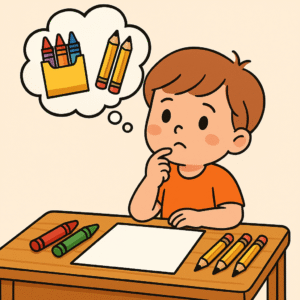

Focus on Effort, Not Outcome
This reinforces persistence and enjoyment of the process.
- Use praise like “You kept trying even when it was tricky!” instead of “Good job, you did it!”
- Avoid over-reliance on rewards or stickers for completing tasks.

Encourage Open-Ended Play
Open- ended play supports creativity and exploration without pressure to “get it right.”
- Set up dramatic play areas (e.g., grocery store, space station) for imaginative role play.
- Offer materials like play dough, loose parts, dress-up clothes, and building blocks.

Create a Safe, Supportive Environment
Children are more motivated to explore when they feel emotionally secure.
- Acknowledge and validate feelings (“It’s okay to feel frustrated when the blocks fall down.”).
- Offer calm support during challenges without taking over.

Follow the Child’s Interests
Following children’s interests builds engagement by tapping into natural curiosity.
- If a child loves dinosaurs, provide dino-themed books, puzzles, and pretend play props.
- Create thematic learning centers around children’s favorite topics.


Model Curiosity and Enthusiasm
Children mimic adults’ attitudes toward learning.
- Share your excitement: “I wonder what will happen if we mix these two colors!”
- Show interest in children’s ideas and creations.

Encourage Problem-Solving and Critical Thinking
It promotes a sense of competence and mastery.
- Ask open-ended questions like “What else could we try?” or “How can we fix this?”
- Present simple science or engineering challenges (e.g., building a bridge from straws).


Experience:
One rainy morning during free play, Daniel discovered a new puzzle on the shelf—one with no box image, no instructions, and no adult saying, “Finish this.” He pulled it out on his own and began slowly sorting the pieces. He didn’t ask for help, didn’t look around to see who was watching—he was just in it. The concentration on his face was something magical.
Other children came and went, but Daniel stuck with it, humming to himself, trying different combinations, flipping pieces around. After about 30 minutes (an eternity in preschool time), he finally placed the last piece. He sat back, smiled to himself, and softly said, “I did it.”
No reward. No applause. Just the quiet pride of doing something hard because it felt good to keep going. That moment was a reminder that children are naturally wired to be curious and persistent—we just need to protect that spark.
By weaving these practices into our daily routines, we can help nurture a lifelong love of learning and a strong sense of personal accomplishment in our little ones—planting the seeds for confident, curious learners who feel proud of how they learn, not just what they learn.

Achievement Motivation
Achievement motivation is that internal spark that drives a child to set goals, tackle challenges, and work toward mastering new skills—whether it’s zipping up their coat or building the tallest block tower without it toppling. In preschoolers, this motivation is deeply connected to their budding sense of competence and independence. When children feel like capable doers, their confidence soars. To support this kind of motivation, it’s key to create an environment that values exploration, allows room for mistakes, and celebrates effort over perfection (Wigfield & Eccles, 2002). After all, it’s not about getting it right the first time—it’s about having the courage to try again.
Here are some simple, effective strategies and classroom-friendly activities to help foster achievement motivation in our preschoolers:

Set Meaningful, Doable Challenges
This encourages goal-setting and pride in accomplishment.
- Offer tasks that stretch a child’s current skills (e.g., threading beads in patterns, building taller block towers, finish the whole puzzle)
- Introduce “challenge of the day” activities that promote effort and engagement.

Celebrate Effort and Progress
It reinforces a sense of growth and capability.
- Use phrases like “You’ve improved so much!” or “You didn’t give up!”
- Display before-and-after work (e.g., name writing, drawings) to show growth.

Offer Opportunities for Self-Assessment
Offering opportunities for self-assessment builds self-awareness and internal drive to improve.
- Ask reflective questions like “What part was easy? What part was tricky?”
- Create “I did it!” stations where children can record (verbally, visually, or with help) their accomplishments.


Encourage Goal-Directed Play
Goal- directed play builds planning and task completion skills.
- Set up play centers with simple tasks or roles (e.g., build a house, make a menu, set up a pretend shop).
- Offer mini “missions” during outdoor play, like obstacle courses or scavenger hunts.
Experience:
I remember a moment from last spring that perfectly captured why effort matters so much more than the final result. We were doing a tricky cutting activity—curved lines, small shapes, lots of concentration required. One of my little learners, Maya, had been struggling with scissors for weeks. She often avoided cutting tasks altogether and would say things like, “I’m not good at this,” before she even tried.
But on this day, something was different. She picked up the scissors, gave me a very serious nod, and said, “I’m gonna try my best.” And she did. Her hands were shaky, and the lines were more “creative curves” than clean cuts, but she kept going. When she finished, she looked up at me with a hesitant smile, clearly unsure if it was “good enough.”
Instead of commenting on the final product, I said, “Maya, I saw how hard you worked. You didn’t give up, even when it got tricky—and that is what helps you get stronger.” Her face lit up. She proudly taped her little masterpiece to the wall next to the others, and from that day forward, she stopped avoiding scissors. She didn’t magically become an expert cutter—but she saw herself as someone who could try, and that changed everything.
Fostering achievement motivation in the early years helps children build confidence, bounce back from challenges, and develop a positive, can-do attitude toward learning that will carry them well beyond the preschool classroom.

Social Motivation
Social motivation is that inner drive children have to connect with others, build friendships, and feel a sense of belonging—because let’s face it, even the littlest humans want in on the group game. In preschoolers, social motivation plays a huge role in how they engage with peers and adults, how they express their needs, and how they start to navigate the complex (and sometimes hilarious) world of group dynamics. It’s also deeply tied to emotional intelligence—children who are socially motivated tend to show more empathy, cooperation, and perspective-taking (Denham, 2006). These are the children who start to ask, “Are you okay?” when someone’s upset or say, “You can play too,” without being prompted. Beautiful stuff, right?
Here are some simple, practical ways to foster social motivation in preschoolers. These ideas are geared toward the classroom but can easily be adapted for home—whether you’re with family or hosting a playdate in a living room full of snacks and tiny negotiations.

Create Opportunities for Peer Interaction
This strengthens bonds and social comfort.
- Pair children for “buddy tasks” (e.g., watering plants, handing out materials).
- Encourage group storytelling or puppet shows where each child has a role.

Provide Emotion-Rich Language and Support
This helps children express and navigate social emotions.
- Encourage children to use feeling words (“I felt left out when…”).
- Offer scripts or prompts when they struggle to join play or solve disputes.

Encourage Cooperative Play
Cooperative play builds teamwork, turn-taking, and shared goals.
- Set up partner or small group games (e.g., building a block tower together).
- Use board games or cooperative puzzles where children work toward a common outcome.


Use Role-Playing to Practice Social Skills
Role-playing prepares children for real-life social situations.
- Set up dramatic play scenarios like a grocery store or doctor’s office.
- Role-play greeting a new friend, asking for help, or resolving a conflict.

Foster a Sense of Belonging
Fostering a sense of belonging increases motivation to be part of the group.
- Start the day with a morning meeting or greeting circle.
- Create classroom jobs or responsibilities that rotate among children.

Celebrate Group Efforts
It reinforces the value of working together.
- Highlight collaborative achievements (“You/We all worked so well as a team to clean up!”).
- Display group artwork or shared projects in the classroom or at home.
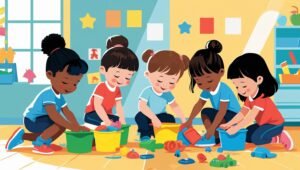
Experience:
During center time, a small group had taken over the block area—three confident builders deep into constructing what they proudly declared was a “super-tall dragon tower.” Off to the side, Olivia hovered. She watched closely, inching a little nearer with every minute, clutching a single block in her hand like a hopeful ticket in.
In the past, Olivia had struggled to join group play. She often waited silently on the edges, unsure how to step in or worried she wouldn’t be welcome.
That morning, I knelt down beside her and gently said, “It looks like you’re interested in their tower. Do you want to be part of it?” She nodded. “Let’s think of something you could say.”
After a moment, she whispered, “Can I build the tail?”
We practiced it once, and then—deep breath—she walked over and asked. One of the boys looked at her, shrugged, and said, “Okay. We need more tail anyway.”
Her whole face lit up. She slid in beside them, carefully added her block to the base, and just like that, she was part of the team.
That small interaction—the courage to ask, the openness to include—was powered by social motivation: her desire to connect, contribute, and feel like she belonged. And in that moment, she didn’t just join a game. She belonged to something bigger than herself.
Fostering social motivation in early childhood helps children feel a genuine sense of belonging—and that sense of connection is what encourages kind, cooperative, and prosocial behavior. These social skills don’t just make the classroom run more smoothly (though that’s a bonus!)—they also support emotional development and academic growth. When educators and caregivers intentionally create opportunities for meaningful interactions, teamwork, and shared problem-solving, they’re fueling children’s internal drive to connect, communicate, and contribute to the world around them. Because when children feel like they matter to the group, they’re far more likely to show up, speak up, and help others do the same.

Self-Determination Theory (SDT)
Self-Determination Theory (SDT) highlights three core psychological needs that are key to fostering motivation and well-being: autonomy, competence, and relatedness. These aren’t just fancy academic terms—they’re the building blocks for healthy emotional development and a genuine love of learning, even in our youngest learners. When preschoolers feel autonomous, they believe they have some control over their choices (even if it’s just picking the red crayon instead of the blue). When they feel competent, they see themselves as capable and successful—whether they’re zipping a coat or solving a puzzle. And when they experience relatedness, they feel emotionally connected and safe with the people around them—caregivers, teachers, and peers alike. When we intentionally nurture these needs, we’re not just boosting motivation—we’re helping grow curious, resilient, and confident little humans who feel empowered to explore the world.
Let’s see how can we foster each of these core psychological needs:

Autonomy – Supporting Independence and Choice
Children are more motivated when they feel they have control over their actions.
- Offer simple, meaningful choices throughout the day (e.g., “Do you want to draw with crayons or markers?”, “Do you want to put your left shoe on first or the right shoe?”)
- Set up self-serve stations for snacks or art supplies to encourage independence.
- Allow children to choose roles during group activities or pretend play.

Competence – Building Confidence Through Mastery
Children need to feel capable and successful to stay engaged.
- Provide appropriately challenging tasks (e.g., multi-step puzzles, simple science experiments).
- Give specific, effort-focused praise (“You tried a new way and it worked!”).
- Celebrate progress and persistence, not just outcomes.

Relatedness – Nurturing Positive Relationships
Feeling emotionally connected fosters trust, safety, and motivation.
- Start the day with warm greetings and individual check-ins.
- Create opportunities for peer collaboration and cooperative play.
- Use circle time or family time to share feelings, stories, or group songs that build connection.

Experience:
During center time, a small group had taken over the block area—three confident builders deep into constructing what they proudly declared was a “super-tall dragon tower.” Off to the side, Olivia hovered. She watched closely, inching a little nearer with every minute, clutching a single block in her hand like a hopeful ticket in.
In the past, Olivia had struggled to join group play. She often waited silently on the edges, unsure how to step in or worried she wouldn’t be welcome.
That morning, I knelt down beside her and gently said, “It looks like you’re interested in their tower. Do you want to be part of it?” She nodded. “Let’s think of something you could say.”
After a moment, she whispered, “Can I build the tail?”
We practiced it once, and then—deep breath—she walked over and asked. One of the boys looked at her, shrugged, and said, “Okay. We need more tail anyway.”
Her whole face lit up. She slid in beside them, carefully added her block to the base, and just like that, she was part of the team.
That small interaction—the courage to ask, the openness to include—was powered by social motivation: her desire to connect, contribute, and feel like she belonged. And in that moment, she didn’t just join a game. She belonged to something bigger than herself.
Early childhood educators and caregivers play a vital role in nurturing these three pillars of motivation—autonomy, competence, and relatedness—by creating environments rooted in connection, trust, and thoughtful, relationship-focused teaching. It’s the little daily moments, from offering choices to celebrating effort, that help children feel seen, supported, and ready to grow.

Goal Orientation
Goal orientation describes the way children approach learning—either with a focus on mastering a new skill (mastery orientation) or with the aim of showing they’re better than others (performance orientation). In the preschool years, it’s especially important to nurture a mastery-oriented mindset, where the focus is on effort, progress, and personal growth. After all, we’re not aiming for little perfectionists—we’re raising curious, resilient learners who aren’t afraid to try, mess up, and try again. When we encourage children to take on challenges, learn from mistakes, and celebrate how they’re growing (not just what they’ve achieved), we help build that all-important inner motivation and a love of learning that can last a lifetime.
Find Below some suggestions to support the goal oriented mindset in preschoolers:

Emphasize Effort Over Outcome
This encourages persistence and pride in the learning process.
- Praise specific actions (“You kept trying even when it was hard!”).
- Display children’s ongoing work to show growth, not just final results.

Model a Growth Mindset
This shows children that mistakes are part of learning.
- Talk aloud about your own learning: “Oops, I made a mistake. Let me try another way.”
- Read books that highlight characters learning through perseverance (e.g., The Most Magnificent Thing by Ashley Spires).


Set Individualized, Achievable Goals
Setting achievable goals helps children track progress and feel successful.
- Use “I can” statements like “I can write my name.”
- Create goal charts with drawings to show effort over time.

Reflect on Progress with the Child
Reflecting reinforces personal achievement and internal motivation.
- Ask reflection questions: “What was tricky? What helped you keep going?”
- Create “learning journals” with pictures or short entries about what they’re proud of.

Provide Task-Based Challenges
It promotes motivation to complete tasks and build mastery.
- Offer puzzles or building tasks that increase in complexity.
- Set up play scenarios with mini “missions” (e.g., build a bridge, solve a mystery).

Experience:
It was a busy morning, and we were doing a simple sequencing activity—cutting and gluing the steps to brushing your teeth (because, you know, life skills and fine motor, all in one go!). I was modeling the task at the front, happily chatting away, when I confidently glued the “rinse” step before the “brush” step.
A few children noticed and whispered to each other. One raised a hand and cautiously asked, “Um… don’t you brush before you rinse?”
I looked down, saw my mistake, and smiled. “Oops! You’re absolutely right. I made a mistake. Let me try that again.” I gently peeled the piece off, reached for the glue stick, and said out loud, “Sometimes we don’t get it right the first time, and that’s okay. That’s how we learn.”
The room relaxed. A few children who had been hesitant to start suddenly picked up their scissors. One said, “I messed mine up too—but I can fix it like you did!”
By talking through my own mistake and showing what it looks like to keep going without frustration or embarrassment, I modeled a mastery-oriented mindset in action. In that moment, I wasn’t just guiding a craft—I was showing them that learning is a process, mistakes are welcome, and trying again is part of the journey.
Us educators and caregivers, we play a powerful role in shaping a child’s goal orientation through the feedback we offer and the environments we create—spaces that value curiosity, persistence, and individual growth over perfection or praise-based performance. When we shift the focus from “getting it right” to “giving it a go,” we help children develop a mindset that’s rooted in learning, not just outcomes.

In the end, we have a truly powerful role in shaping the motivation of preschool-aged children. It starts with creating emotionally supportive environments where learning feels safe, exciting, and full of possibility. By modeling a positive attitude toward learning and responding to children’s efforts in meaningful, thoughtful ways, we show them that how they try matters just as much as what they achieve. Motivation grows when we offer encouragement, offer age-appropriate challenges, and focus on effort—not just outcomes. Through warm relationships and consistent guidance, we help children build a sense of autonomy, competence, and belonging—three key ingredients for developing a strong internal drive. When we validate their feelings, celebrate their small steps, and give them room to explore and make choices, we’re not just teaching them—we’re inspiring a lifelong love of learning.
As we’ve explored, motivation in early childhood is shaped by so many factors—supportive environments, meaningful relationships, and the freedom to try, stumble, and try again. But there’s another powerful thread that runs right alongside motivation in the emotional intelligence journey: empathy.
In the next post , we’ll dive into the different layers of empathy and how we can nurture this deeply human skill in even our littlest learners.
Until next time—keep cheering on the tiny triumphs, celebrating effort over outcomes, and pretending stickers aren’t still stuck to your elbow from last week.
— The Teacher Behind the Crayons
💬 I’d love to hear from you! Have you had a “pause and breathe” moment with your little learners? Or maybe a funny story about a fire drill and a glitter explosion? Share your thoughts, questions, or classroom wins in the comments below—let’s keep the conversation going.
References
Denham, S. A., Bassett, H. H., Zinsser, K., & Wyatt, T. (2012). How Preschoolers’ Social–Emotional Learning Predicts Their Early School Success: Developing Theory-Promoting, Evidence-Based Practices. Early Education and Development, 23(6), 845–864. https://doi.org/10.1080/10409289.2011.636123
Ryan, R. M., & Deci, E. L. (2000). Intrinsic and extrinsic motivations: Classic definitions and new directions. Contemporary Educational Psychology, 25(1), 54–67. https://doi.org/10.1006/ceps.1999.1020
Wigfield, A., & Eccles, J. S. (2002). Development of achievement motivation. San Diego, CA: Academic Press.
Denham, S. A. (2006). Social-emotional competence as support for school readiness: What is it and how do we assess it? Early Education and Development, 17(1), 57–89. https://doi.org/10.1207/s15566935eed1701_4
You May Also Like
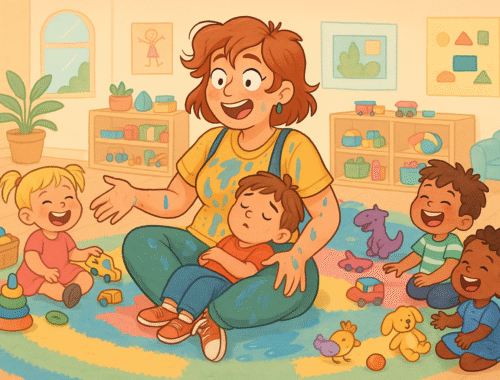
A Lap, A Leak, and the Importance of Emergency Underwear
June 23, 2025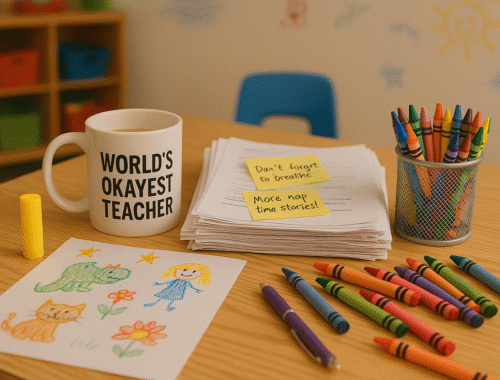
The Teacher Behind The Crayons
June 18, 2025